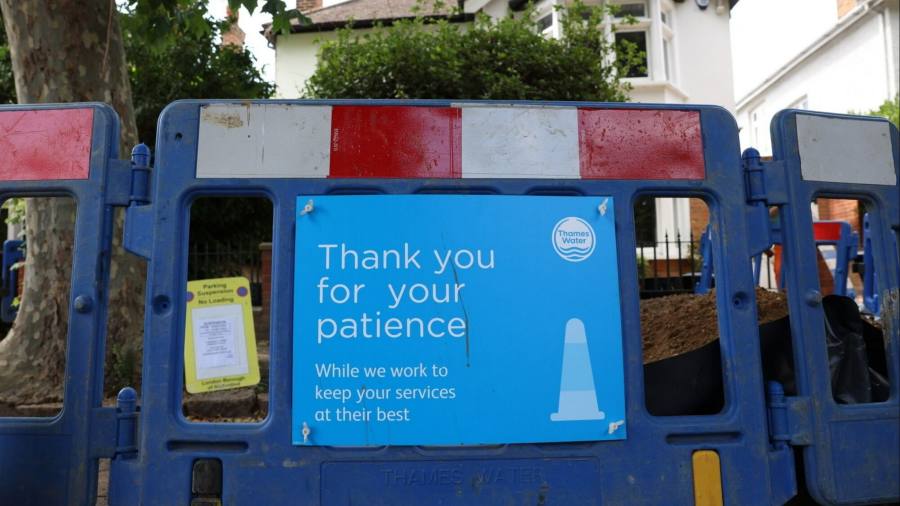Receive free Thames Water PLC updates
We’ll send you one myFT Daily Digest latest roundup email PLC Air Thames news every morning.
Our world is filled with opinions about Thames Water. Here, from Citigroup analyst Jenny Ping, there’s more:
Ofwat has been criticized for not being tough enough as a regulator, especially with the company taking cash from the business rather than investing it back into the business. If one or more of the UK’s water utilities collapse financially, we believe this may actually help Ofwat to demonstrate that they are quite resilient in the sector, with those not meeting their licensing obligations absent. This could put pressure on Ofwat to ensure this does not become an endemic problem across sectors and make it easier to propose a fair set of regulatory proposals for AMP8.
AMP in AMP8 stands for asset management period. It’s Ofwat’s framework for permitted returns that will run for five years from April 2025. Citi argues that if Thames Water were to die sometime between now and then it would prove the current regime is fit for purpose, which “could actually be a positive for the sector. ”.
Exactly what Citi means by “collapse” is not defined. As discussed at length here and elsewhere, Thames Water’s regulatory assets are fenced off within the operating company so the onus stops for investors at the parent company level. The government’s choice, if push comes to shove, will be between injecting equity at the topco level or just above the ringfence.
As a reminder, there is £14.3 billion of debt attached to the Thames Water opco secured by £17.9 billion of regulated operating assets. Although shareholders would almost certainly be wiped out by any kind of government intervention, an injection of equity right on top of the ringfence has the convenience of protecting assets while focusing only on junior debt holders—as in, the Kemble entity that is completely dependent on opco dividends.
Of all the available bailout lines, this is probably the least bad. That’s what the market has assumed, on the balance of probabilities, since Thames Water hit the front pages last week. But because nothing had to happen immediately, and because no one was prepared to talk about specific contingency plans, certainties were few and far between.
Cannon fodder junior debt has rallied for three straight sessions to trade around 60p in pounds while opco debt — the stuff that’s hedged with creditor protection through the whole securitization of business — is drifting more widely. There is also less sector transmission. Threats of nationalization may be meant to coax Thames Water investors into adding equity but talk of a crisis is self-fulfilling, especially within a hate-filled sector.
Publicly, water companies posit stakeholder engagement and self-regulation as the best way forward—see the leaked memo from Severn Trent CEO Liv Garfield about how utilities should rebrand to become “social purpose companies” so they “appeal to Labor leadership.” . Personally, there is a desire to sell the idea that lack of investment has become a mutual benefit.
Here (via email) is how a sales specialist-trader at JPMorgan summarizes the situation:
There is something deeply disheartening about those who are entrusted with delivering clean water that is actually polluting our rivers and seas due to decades of underinvestment in the system. Extracting billions in dividends and over-taxing the sector adds a dire economic angle to that environmental neglect. The sector is free from privatized debt and now has £60 billion in debt — or nearly 70% of the aggregate Regulated Capital Value (RCV).
Everything is wrong! These monopoly utilities have over-utilized social assets and generated tremendous profits. The health of our environment and the sacredness of water safety have been neglected. Many argue that regulators have allowed this to happen for decades of comfortable coexistence. Those people would argue OFWAT is not fit for purpose. The case for nationalization to punish ‘bad financiers’ and regain control of critical natural monopolies is compelling… until we weigh the practicalities of finding a solution.
Today we need investment. New reservoirs, replacement of sewer pipes, increased efficiency and these are not easy challenges for public ownership to solve. Jeremy Hunt does not want to put £60 billion of industrial debt on his balance sheet or fund the huge capex burden going forward.
So while we want revenge, we actually need rapprochement. It takes a lot of emotional dexterity but the answer is to offer higher returns on much-needed capital outlays – and fund them in the only way that higher bills allow. Neither of us would choose to start here. It doesn’t seem fair or right. But there is no alternative. The cheap bills are another benefit of decades of under-investment in Britain’s water infrastructure… The cosmetic era, the short-term good times are over. The price of water must rise to allow the necessary investment to flow into the sector. Those returns will accrue to private capital but that is capitalism… Natural monopoly requires private sector capital along with strong regulation to ensure the long term preservation of the integrity of the system not just its direct monetization.
Water utilities need to publish their plans for the AMP8 business plan in October. The government and Ofwat had indicated before the crisis that the bill would be allowed to rise, but have since appeared paralyzed as profiteering and dead fish dominate the discourse.
Under these circumstances, it is utterly absurd to think, as Citi’s Ping argues, that everyone’s bargaining power might be helped in the long run through ritual sacrifices.
Further reading:
— FT.com/Thames Water
#Thames #Water #die #teach #lesson #Citi
